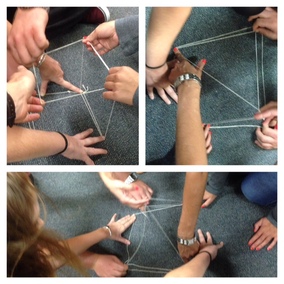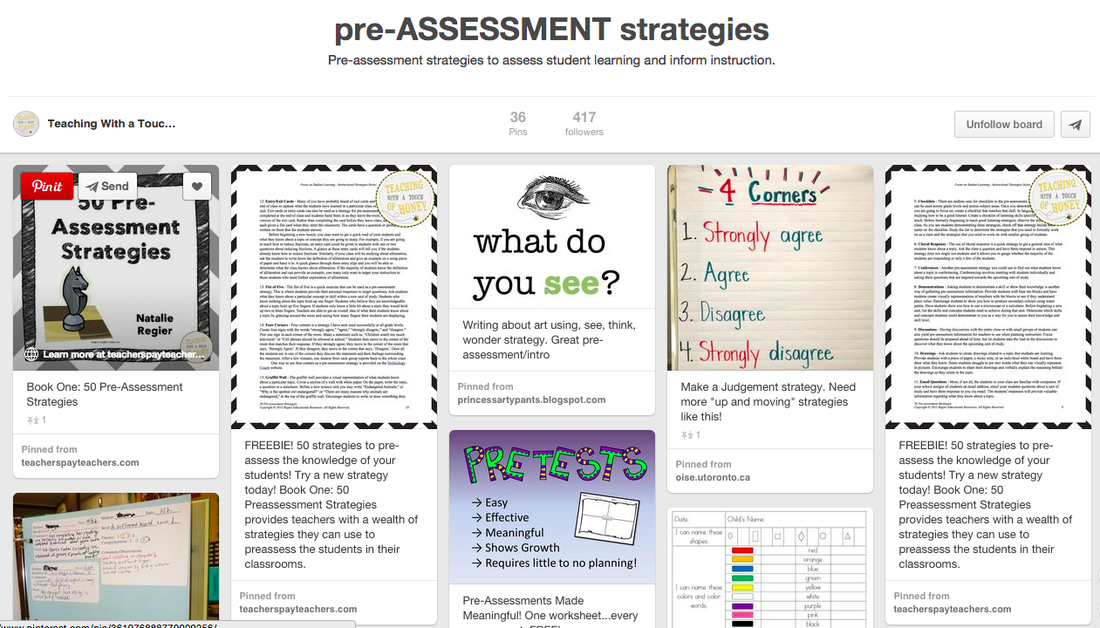Pure mathematics is, in its way, the poetry of logical ideas. ~Albert Einstein
“Assessment is today’s means of modifying tomorrow’s instruction.”
- Carol Ann Tomlinson
https://www.pinterest.com/natalieregier/pre-assessment-strategies/
Pre-assessment provides valuable information about what is already known about a topic and readiness to start new instruction. Discovering prior knowledge allows the teacher to present new information at an appropriate level for the students. This process should continue throughout the learning process, so lessons can be adjusted according to student need. Listed below are some methods to pre-assess.
Carousel Brainstorm - Chart papers containing statements or issues for student consideration are posted around the classroom. Groups of students brainstorm at one station and then rotate to the next position where they add additional comments. When the carousel “stops” the original team prepares a summary and then presents the large group’s findings. A Carousel Brainstorm is an active, student-centered method to generate data about a group’s collective prior knowledge of a variety of issues associated with a single topic.
Concept Maps - Ask students to create a "map" of ideas connected with a topic. They should consider how the topics link to each other and use lines or "linking" words to join the concepts together and describe the relationship. They can then revisit these maps later in the study (using a different color marker to add new ideas) or draw new ones that reveal their expanded understanding.
Four Corners Inquiry – Students are given an opportunity to formulate their own views and opinions. Students are asked to consider the topic and determine whether they strongly agree (SA), agree (A), disagree (D), or strongly disagree (SD) with a statement. They are then asked to move to the appropriate corner of the classroom identified with one of the options. Students should discuss their positions with the others in their group and present their opinions to the rest of the class.
KWL Charts - K-what does the student know? W-what does the student need and want to know? L-what did the students learn? This is an effective pre-assessment tool and summative evaluation tool. The "L" can also be used the as part of an open-ended question on a test allowing the students to share the depth of knowledge that was gained in the unit of study. Click here to access a KWL Chart
Think - Ink - Pair - Share - A way to get students to reveal what they know or believe about a topic is to begin by having them commit their thoughts to writing. To assess what the group knows, have students discuss their ideas in pairs, and then to share them with the large group.
Turn & Talk - During a lesson, there may be opportunities to have the students do a turn & talk activity for a few minutes. This allows students to talk about the information presented or shared and to clarify thoughts or questions. This is an effective alternate strategy to asking questions to the whole group and having the same students responding. All students have a chance to talk in a non-threatening situation for a short period of time.
Yes/No Cards – Students make a card with Yes on one side, No on the opposite side. Teachers ask an introductory or review question. Students who know the answer hold up the Yes card, if they don’t know the answer they hold the No card. This is very effective to use when introducing vocabulary words that students need as a knowledge base for a specific unit of study.
Here are some other pre-assessment methods to consider:
Carousel Brainstorm - Chart papers containing statements or issues for student consideration are posted around the classroom. Groups of students brainstorm at one station and then rotate to the next position where they add additional comments. When the carousel “stops” the original team prepares a summary and then presents the large group’s findings. A Carousel Brainstorm is an active, student-centered method to generate data about a group’s collective prior knowledge of a variety of issues associated with a single topic.
Concept Maps - Ask students to create a "map" of ideas connected with a topic. They should consider how the topics link to each other and use lines or "linking" words to join the concepts together and describe the relationship. They can then revisit these maps later in the study (using a different color marker to add new ideas) or draw new ones that reveal their expanded understanding.
Four Corners Inquiry – Students are given an opportunity to formulate their own views and opinions. Students are asked to consider the topic and determine whether they strongly agree (SA), agree (A), disagree (D), or strongly disagree (SD) with a statement. They are then asked to move to the appropriate corner of the classroom identified with one of the options. Students should discuss their positions with the others in their group and present their opinions to the rest of the class.
KWL Charts - K-what does the student know? W-what does the student need and want to know? L-what did the students learn? This is an effective pre-assessment tool and summative evaluation tool. The "L" can also be used the as part of an open-ended question on a test allowing the students to share the depth of knowledge that was gained in the unit of study. Click here to access a KWL Chart
Think - Ink - Pair - Share - A way to get students to reveal what they know or believe about a topic is to begin by having them commit their thoughts to writing. To assess what the group knows, have students discuss their ideas in pairs, and then to share them with the large group.
Turn & Talk - During a lesson, there may be opportunities to have the students do a turn & talk activity for a few minutes. This allows students to talk about the information presented or shared and to clarify thoughts or questions. This is an effective alternate strategy to asking questions to the whole group and having the same students responding. All students have a chance to talk in a non-threatening situation for a short period of time.
Yes/No Cards – Students make a card with Yes on one side, No on the opposite side. Teachers ask an introductory or review question. Students who know the answer hold up the Yes card, if they don’t know the answer they hold the No card. This is very effective to use when introducing vocabulary words that students need as a knowledge base for a specific unit of study.
Here are some other pre-assessment methods to consider:
- Anticipation journals
- Drawing related to topic or content
- Game activities
- Graphic organizers
- Guess Box
- Informational surveys/Questionnaires/Inventories
- Initiating activities
- Journals
- Picture Interpretation
- Portfolio analysis
- Prediction
- Questioning (consider using Costa's Levels of Questioning - an AVID technique)
- Self-evaluations
- Show of hands to determine understanding
- Standardized test information
- Student demonstrations and discussions
- Student interviews
- Student products and work samples
- Teacher observation/checklists
- Teacher prepared tests
- Writing prompts/samples

With the new NSW Mathematics syllabus coming in, teachers have a wonderful opportunity to reassess and re-evaluate not only what we teach in mathematics but how we teach mathematics.
With this opportunity to disrupt mathematics teaching, we can provide students with more opportunities to explore and investigate their own challenges. And just like any teaching we use a range of modeled, guided and independent tasks. Of course we always need to bring more movement and laughter in our learning, providing students more enjoyment and active engagement with their learning.
With this opportunity to disrupt mathematics teaching, we can provide students with more opportunities to explore and investigate their own challenges. And just like any teaching we use a range of modeled, guided and independent tasks. Of course we always need to bring more movement and laughter in our learning, providing students more enjoyment and active engagement with their learning.

